The timing belt is an important element responsible for the synchronous and smooth operation of the camshaft and crankshaft of the internal combustion engine. The part is responsible for the function of timely opening and closing of the valves. A fully serviceable belt turns the camshaft at a strictly defined pace – exactly twice as slow as the crankshaft turns. As the camshaft rotates, a fuel-air mixture (FAM) is fed into the engine cylinders and exhaust gases are expelled through the exhaust system. A timing belt break disrupts the entire normal cycle of the power unit, and can lead to serious consequences.
Belt drive was introduced by manufacturers in order to produce lighter and cheaper automobile engines. Along with this, the noise of the running motor was reduced to a great extent. But it was the average consumer who paid the price. Innovations in terms of timing belt installation brought maintenance and replacement problems. The operating life of the belt drive is much shorter, and it is necessary to constantly “monitor” its condition and tension.
The designers intended that the timing belt itself should have both high strength, which is close to a chain, and be quite elastic and wear-resistant. As a result of design “endeavors” and appeared three-layer design of the timing belt.
Replacement periodicity of the timing belt
Even if the engine does not cause any complaints, do not forget about timely checking the condition of the timing belt, because it also has a limit of wear. You can find out this value from the technical passport of the car, but you can do much easier: it is recommended to change the part every 50 thousand kilometers of mileage. If you bought a used car and do not know when the last time the replacement was made, inspect the belt visually. The appearance of microcracks on the body is the first sign of concern.
Do not panic, because microcracks do not mean that the node will break at the first load. It has a metal base of thin rods inside. This allows it to withstand impressive shock loads and not tear for a long period of time. On some models, car manufacturers install impact-resistant belts with reinforced metal cord. Thus, it is possible to extend the service life by about 30%.
Causes of the breakage of the timing belt
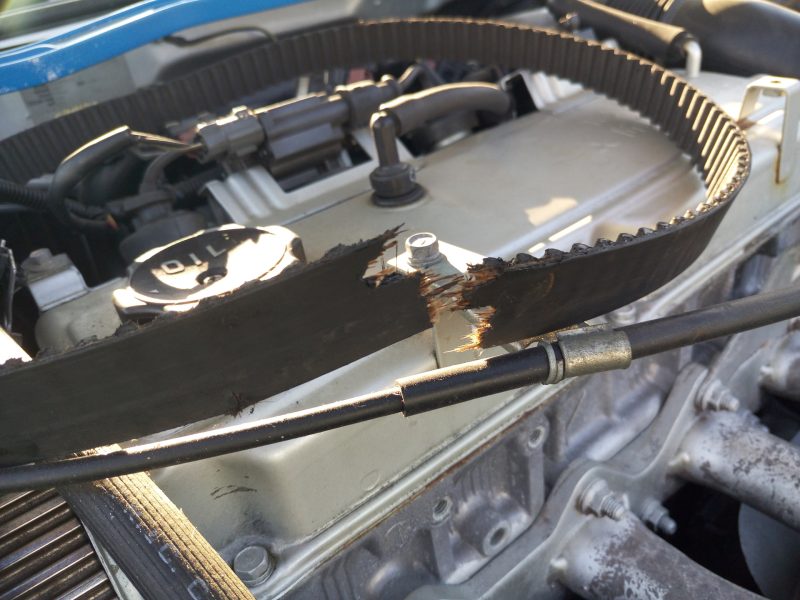
There are several reasons for the breakage of the timing belt, and to determine them, you need at least a little understanding of the powertrain. Often, drivers encounter this problem after replacing the belt or repair of the timing mechanism, which is associated with the replacement of valve guide bushes.
The timing belt is one of the main elements of the car, which should be timely and qualitatively serviced. In this case, the reasons for the breakage of the timing belt can be the following:
Nontimely replacement of the node
As a rule, the manufacturer recommends changing the product after 60-70 thousand kilometers. But the recommendations can differ – each manufacturer can specify its own time parameters, which are often more or less than the period we mentioned.
Irregular operation
The belt can break not only because of natural aging, but also because of errors in the operation of the entire unit. For example, if the tensioners, rollers or pump jams during driving, the resulting impulse can lead to the rupture of the timing belt. It looks strong and does not tear. When the crankshaft rotation reaches 5-6 thousand revolutions, any sharp impulse can lead to irreparable consequences. Special attention should be paid to the belt tension. Often the cause of rupture is its overstretching. On the other hand, weakening of the tension can lead to a similar problem – the belt slipping from the pulley grooves. The same situation is also likely to occur if one of the pulleys has a lot of play. That is why it is so important to check the tension of the timing belt and the condition of all elements of the system.
Oil on the surface
If the first traces of oil or coolant appear on the timing belt, the product must be replaced. Otherwise, inefficient operation of the entire timing mechanism, belt slippage, its slipping off the pulley and even breakage is possible. Many motorists make a big mistake – they simply wipe off the existing contamination with a rag and continue to operate the car.
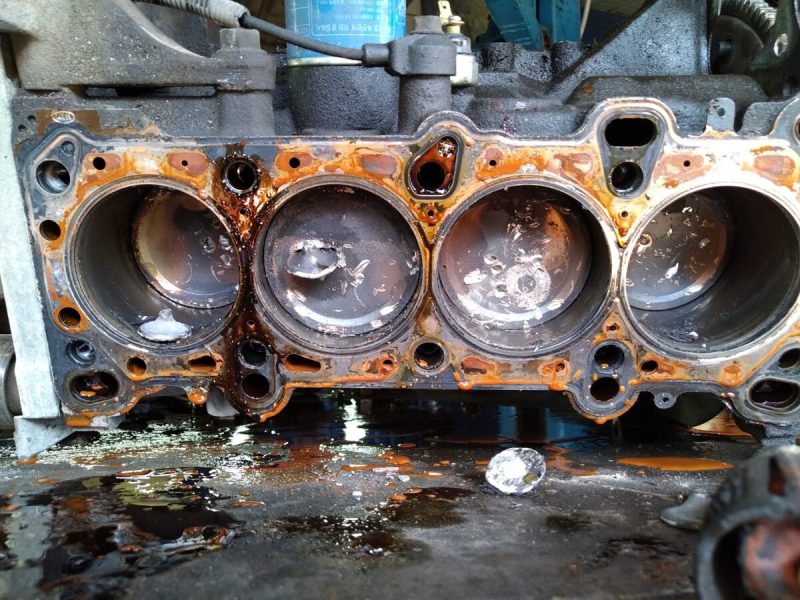
As practice shows, once the technical fluid gets on the texture of the belt, it is impossible to get it out. Rubber literally absorbs oil and loses its qualities. You can only be saved by replacement.
Low quality of the product
When buying a timing belt in the market “on the cheap” be prepared for “surprises” in the process of operation. Keep in mind that savings in such a matter will inevitably lead to even greater costs in the future. If you buy parts for the car, they must be original. In this case, you will be sure of their quality and the stated service life. Masters at the service station are well known situations when, because of a few hundred rubles of savings, car owners threw tens of thousands in the repair. This is not surprising, because the timing belt of poor quality can not pass and 20 thousand kilometers. Believe me, to drive and expect that the belt at any moment will hold out – the pleasure is not the best.
External damage
Due to natural wear and tear or poor quality, various defects may appear on the belt, for example, depressions, cracks, delamination of threads on the end part of the product and so on. Such defects can not and should not be eliminated. The only way out in this case is to install a new belt. Ignore the problem is also not worth it, because at maximum load, even a small defect will develop very quickly and will cause the belt to break. Subsequently, you can blame yourself for your carelessness for a long time, but you can’t get back the past.
Harsh climate and active driving
Take into account that the operation of the car in conditions of too low or, conversely, too high temperatures requires a special approach to repair. In particular, sharp and frequent changes in temperature conditions can wear out the timing belt faster, and especially if it is of low quality. As a consequence, it is better to replace it much more often than the manufacturer itself recommends.
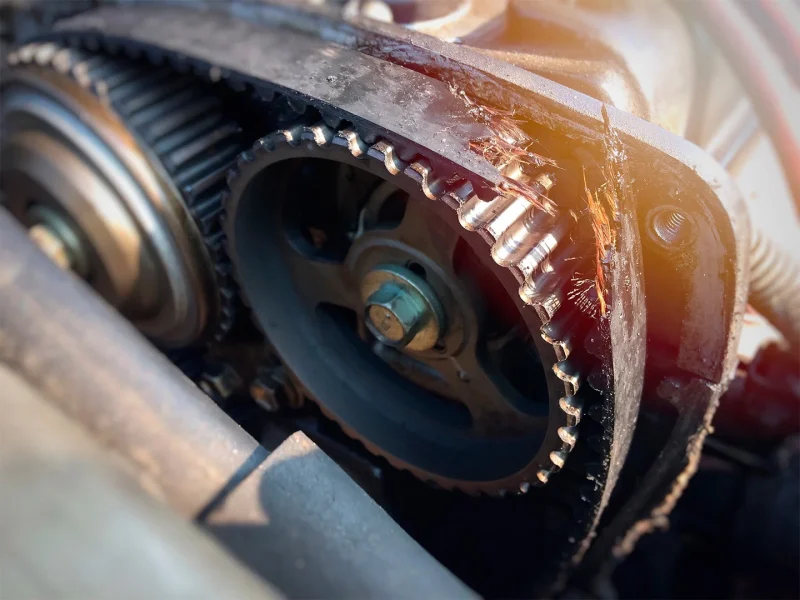
Signs of a breakage of the timing belt
In most cases, when the timing belt breaks, a pop is heard, and the engine stalls, although all other automotive elements continue to function normally. Re-starting the engine in this case is most often accompanied by a metallic knock and easy rotation of the starter, due to the lack of compression in the cylinders. Although in the presence of any suspicion of a possible rupture of the product to make a restart of the engine before inspection is not worth it.
At the first suspicion of a breakage of the timing belt should stop the car and lifting the hood to inspect the condition of the belt, if there is such an opportunity with quick access, as a rule, there is no such opportunity.
In the most severe cases, when restarting the car, a metallic knocking sound may be heard somewhere in the engine area. At the moment of the belt break itself, you may hear a sharp characteristic clap (but with the stereo on, you may not notice it).
Otherwise, you will have to find out whether the valves bend when the timing belt breaks and what other “surprises” there may be.
Consequences of the breakage of the timing belt
The most terrible thing in the problem we are considering is the possible consequences of the breakage of the timing belt. And they can be different, starting from the need to replace the timing belt to overhaul the engine and restore the timing mechanism. Here a lot depends on two factors – the engine, timely reaction and luck. The most difficult situation is when the valves bend because of the timing belt breakage.
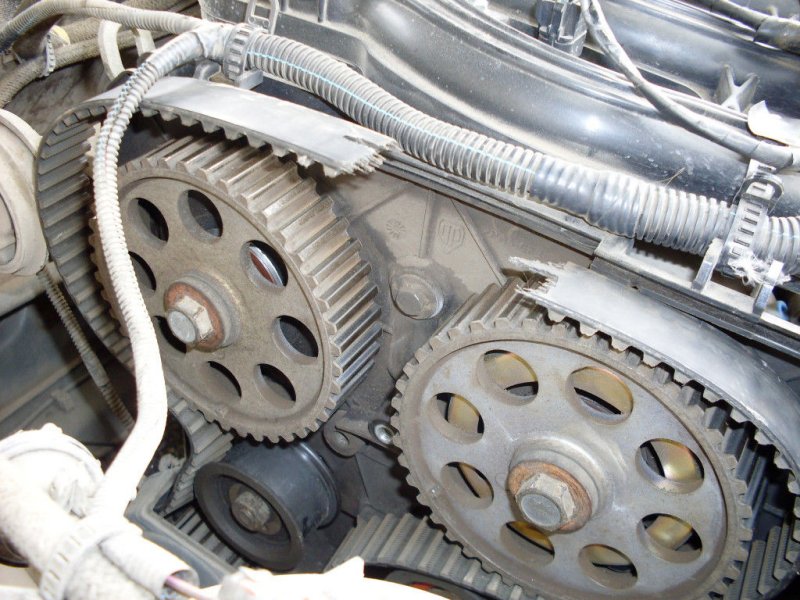
The consequences of the breakage of the timing belt depend directly on the design of the powertrain. In fact, the simpler the engine is arranged, the higher the probability that nothing will be damaged by the breakage. In case the valve piston in the open position does not reach the bottom of the piston at the top dead center position on the engine, it can be considered lucky – in case of a break, only the belt itself will have to be replaced. But you don’t always get off that easy. Current multi-valve engines are aimed at increasing power characteristics and they lack deep enough potholes under the valve plates. As a result, when the timing belt breaks, the position of the timing shafts stops at the point it was at the time of the break. The crankshaft, which is spun by the flywheel, by virtue of its inertial motion is still spinning and meets the piston. The simplest thing that can happen as a result of this is the bending of the valves. In this case, it is necessary to dismantle the block head.
If the timing belt broke at idle speeds, then it will require, as practice shows, the replacement of only a couple or three valves, and if the transmission, then most likely all. But experienced mechanics in any case recommend complete replacement of the entire set of valves. However, the guide bushings may burst, which threatens to repair the cylinder block or its replacement. Less often, even from the impact of the heads on the piston, the second one is destroyed. It also happens that the belt broken at high speed contributes to the bending of all sixteen valves, bursting of bushings and penetration of the pistons with fragments. In this case, the repair of the power unit will be very expensive. Motor statistics show that some engines are prone to get the above damage when the timing belt breaks, and mostly these are units from Japanese manufacturers. Leading here are DOHC Nissan, Mazda, Toyota, Subaru and others. But the most serious consequences of a timing belt rupture are manifested in diesel engines. Due to its specific design, in the position of the top dead center valves have almost no stroke, so there is a destruction of a whole chain of parts at once: the camshaft and its bearings, pushrods and deformation of connecting rods. And the breakage at high speed of the power unit threatens even a major overhaul of the cylinder block.
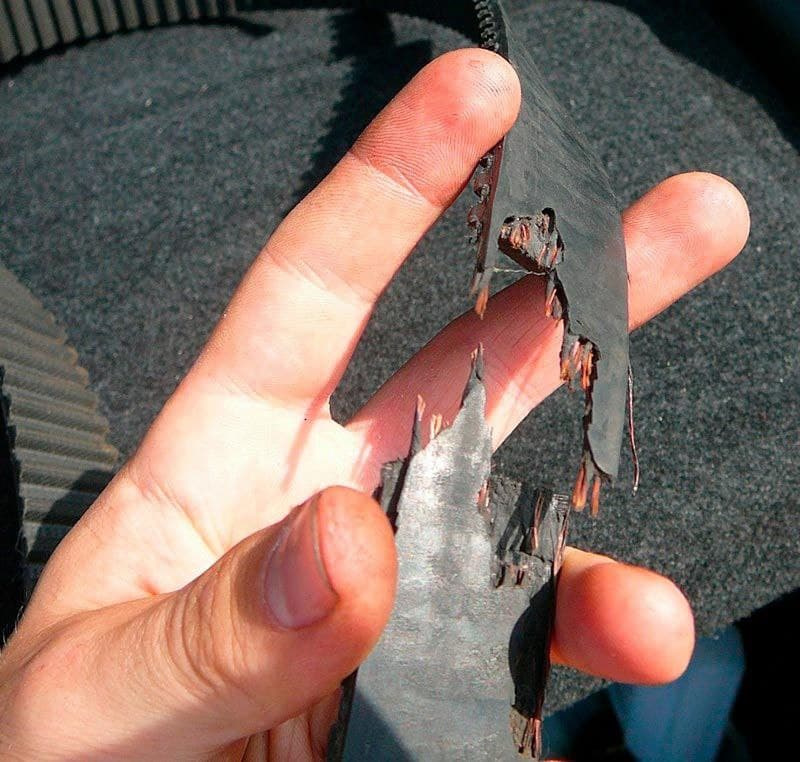
What to do to avoid the breakage of the timing belt? A serious unpleasantness for every car owner is the moment of breakage of the timing belt. In this case, it can be said with full confidence that it will be necessary to restore more than one bent valve. Depending on what design features the power unit has, their number can vary, and not the fact that in the downward direction. Thus, in sixteen-valve engines it happens that 75% of valves fail, that is, as many as 12! It is simply impossible to continue the trip with such a catastrophic failure of the power unit. It is even worse when the timing belt failure affects the piston system. In this case, expensive repairs are guaranteed and a lot of lost time to fully restore the engine and the performance of the entire car as a whole. Therefore, in no case do not bring your car to the state of occurrence of such a situation. And for this purpose it is necessary to follow a few specific procedures, thanks to which you will usually save yourself from the unpleasantness of the timing belt breakage. Observe them, and you will not only avoid huge investments in the repair of your car, but also significantly save yourself time and nerves.
Breaking the timing belt: causes and consequences
| Causes of the breakage of the timing belt | Consequences of timing belt breakage |
|---|---|
| Timely replacement of the belt | Valve bending when the valves meet the piston, which requires disassembly of the engine and replacement of the valves. |
| Misuse | Damage to pistons, valves and cylinders, which can lead to major engine overhaul. |
| Oil or other fluids on the belt | Disturbance of the timing mechanism, belt slippage or belt breakage, which can damage the engine. |
| Low belt quality | Belt breakage at low mileage (less than 20,000 km), which will result in serious engine damage. |
| Belt damage (cracks, tears, wear) | Fast destruction of the belt under load, which leads to rupture and engine damage. |
| Extreme climatic conditions or aggressive driving style | Accelerated belt wear, which requires more frequent replacement and can lead to belt breakage and costly repairs. |
